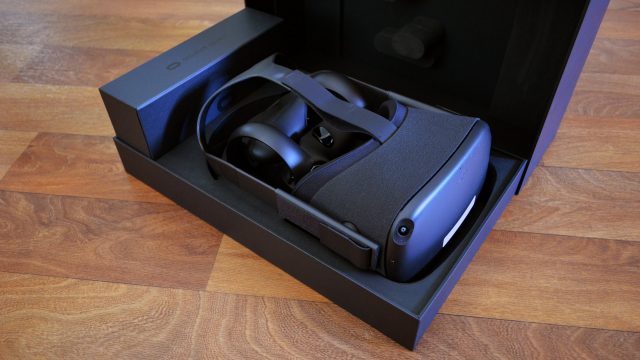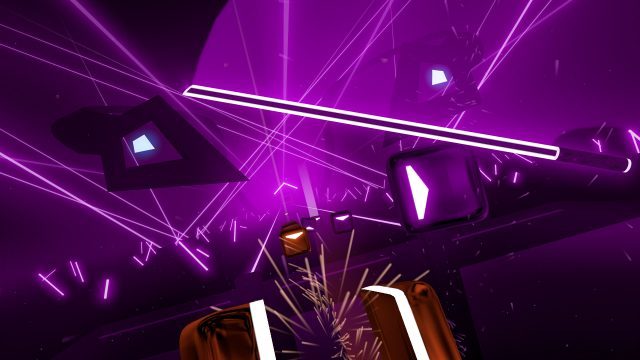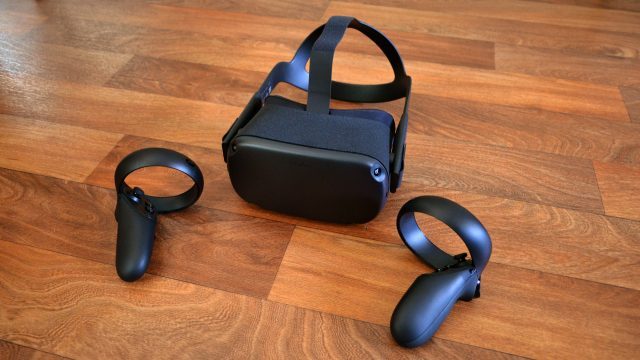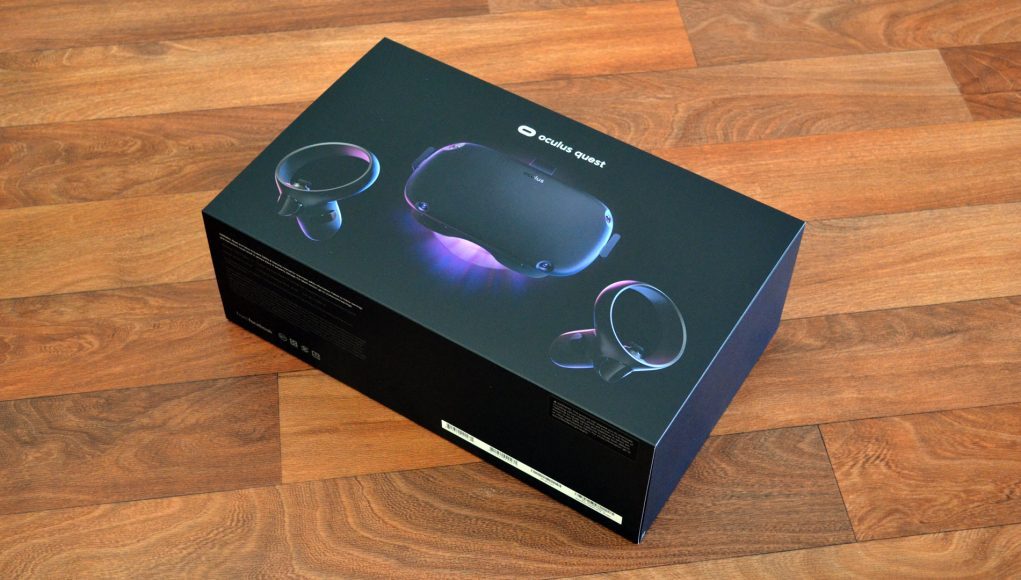Experience
Setup, Companion App, & Passthrough

It’s quick and easy to get Quest going out of the box. The Oculus app (available on iOS or Android) walks you through the setup process which involves pairing the controllers and updating the headset’s firmware (if necessary). You can also use the app to browse the Store, purchase and install games, and browse your game Library.
When you first put on Quest, you’ll see a pass-through video view of your room and you’ll be asked to set up a Guardian space (the boundary around your playspace which keeps you from running into objects and walls). To do this you just point your controller at the ground and trace a line around your playspace; it’s quick and simple compared to the procedure on Rift, which requires a back and forth between your computer screen and several additional steps.
From this point forward, your Guardian boundary will be saved, and if you walk outside of it you’ll see the passthrough view. If the room changes too much (like if objects are moved or lighting changes dramatically) the Guardian may be forgotten and need to be reset.
Being able to see the passthrough video is really nice because it makes it easy to pick up your controllers after putting the headset on so that you don’t have to fiddle with them or have them dangling from your wrists. However, it only activates if you put your headset on when you’re outside of the playspace; I would personally prefer that any time you put the headset on from standby it would default to the passthrough view (to make grabbing controllers easy) until you hit a button to confirm that you’re ready to hop into VR.
Unfortunately there’s no quick-toggle function to enable passthrough when you just need to see outside of your headset for a few seconds (like to talk to someone who needs your attention). You can activate it by pressing the Oculus menu button and then hitting another button in the menu, but this takes a few seconds and thus loses a good portion of its utility as a way to quickly peek outside of the headset.
Content

It will be a while yet until we actually have access to the full Quest launch lineup, but the apps we have had access too so far have been all generally pretty good, and include some of VR’s top content like Beat Saber, Superhot VR, Keep Talking and Nobody Explodes, Virtual Virtual Reality, and more. Here’s the full launch lineup for Quest:
- Angry Birds VR: Isle of Pigs
- Apex Construct
- Apollo 11
- Bait!
- Ballista
- Beat Saber
- Bigscreen Beta
- Bogo
- Bonfire
- Box VR
- Creed
- Dance Central
- Dead and Buried 2
- Drop Dead: Duel Strike
- Electronauts
- Epic Roller Coasters
- Face Your Fears 2
- First Contact
- Fruit Ninja VR
- Guided Tai Chi
- I Expect You To Die
- Job Simulator
- Journey of the Gods
- Keep Talking And Nobody Explodes
- Moss
- National Geographic VR Explore
- Nature Treks
- Ocean Rift
- Oculus Browser
- Oculus Gallery
- Oculus TV
- Oculus Video
- Orbus VR
- PokerStars VR
- Racket Fury: Table Tennis
- Rec Room
- Robo Recall
- RUSH
- Shadow Point
- Skybox VR Video Player
- Space Pirate Trainer
- Sports Scramble
- SUPERHOT VR
- The Exorcist: Legion VR
- Thumper
- Tilt Brush
- Ultrawings
- Vader Immortal
- Virtual Desktop
- Virtual Virtual Reality
- VR Karts
- VRChat
- Wander
While most of these won’t be new to existing VR users, it’s really pretty amazing to have this kind of quality VR content on a headset that’s relatively inexpensive, easy to use, and portable. Unlike Go, which launched with “more than 1,000 apps” (but hardly any of note), Quest actually has a bunch of games that are worth recommending to those who’ve never played them, and a few exciting new titles on the way (like Vader Immortal).
Existing VR users aren’t going to get as much bang for their buck out of the gate, considering how many of these are ports of older games, so Oculus will have to keep up the pace of pushing out new Quest content to maximize the headset’s potential.
Friction, Standby, & Battery Life

When you take Quest off your head and set it down, it’ll automatically go to sleep after 15 seconds (this time is adjustable). It generally wakes up surprisingly quickly (within two seconds or so), which makes it much more inviting for hopping into a quick VR session than first-generation products which typically require launching software on your computer and potentially tweaking sensors before playing. Even when Quest is in standby, it holds onto the current game state which means in most cases you’ll be back up and playing in seconds right where you left off, even if you haven’t touched the headset in hours.
This synergizes well with content that offers short and fun sessions. Throughout my time testing Quest, I’ve played plenty of 15 minute Beat Saber sessions that I wouldn’t otherwise have chosen to do so on another headset because of the prep time involved. And it’s that reduction in friction that will likely stand out to be one of Quest’s biggest improvements over what’s come before.
Though I haven’t had a chance to drain the headset in a single session, Oculus’ advisory of around 2 hours of battery life for gaming with Quest feels about right. And while that might seem somewhat on the low side, I haven’t yet had any issue with it as my play sessions for the available content have consistently been well under two hours at a time.
The battery fares pretty well in standby as well, dropping roughly 1% every two hours despite being ready to spring awake for some game time.
– – — – –
Got more questions? We’ve got more answers. Drop us a line in the comments below.
Disclosure: Oculus provided Road to VR with a Quest headset.







